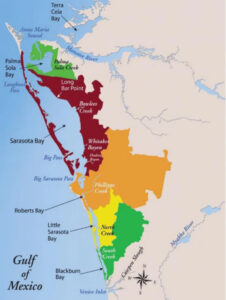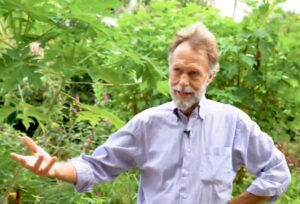Activist argues we should build community and government around watersheds. And create a shared vision.
By Johannes Werner
Original Air Date: Jan. 1, 2024
Host: John Lambie has been in and around water on the Florida Suncoast all his life. The co-creator of Florida House – that’s the educational institution that was an entry point to thinking and planning around sustainability for two generations of Sarasotans – remembers spearfishing in Sarasota Bay off Siesta Key when the water was pristine and marine life aplenty. He knows the ins and outs of the Myakka River and Manatee River. So it’s no surprise Lambie argues that communities should build politics and government around water — watersheds, to be precise. We talked to him about his big-picture ideas.
John Lambie: I grew up on Siesta Key, and I was swimming in Gulf waters and Bay waters that were crystal clear in the 50s, literally 100-foot visibility, common everywhere, and huge animals in the water, as well as just teeming with smaller fish and aquatic wildlife of every sort, seven-foot manta rays, immense sharks. None of them looked at me like food, but I was looking at the smaller ones as food. So I did a lot of spearfishing, and it was just amazing to grow up here in such healthy water.

The Manatee River and Myakka River watersheds frame eight coastal creek watersheds along Sarasota Bay.
Johannes Werner: John Lambie hands out a business card that displays the words “Future By Design” in bigger letters than his name. He was one of the first solar entrepreneurs here in the last century, when the Sunshine State seemed to be the ripe for this brand-new technology. But I’m digressing. We want to focus on water.
Lambie believes water is what defines us humans — after all, it makes up 70% of our bodies — and water is what should bring us together.
He likes to talk about unintended consequences. Lambie brings up the construction of the Intracoastal Waterway.
JL: Back in the 1950s, they thought it was a good idea to cut what’s called the Intracoastal Waterway through the bays, from Texas to Maine, so that there would be safe interior, through the bays, commercial boat traffic potential. So in the shallow — three or four foot deep at most — seagrass-covered mucky bay bottom that characterize our coastal bays, they cut a 12-foot deep, 200-foot wide slot in that muck, cut through the sea grass. So every tide is scraping the side of the channel and delivering just a little bit of mud and stuff into the water column. So where I started diving in the Gulf here with 100-150 foot visibility, that’s rarely attained anymore. It’s just an unintended consequence of the good idea to cut an Intracostal Waterway.
JW: The problems we create leads us to come up with fixes and solutions. Suburban sprawl and the creation of an extensive stormwater management infrastructure is a prime example. But the solution often creates a bigger problem, says Lambie.
JL: Since we’ve been here, we didn’t like the standing water much, so we’ve ditched and drained it a lot. And so there’s hundreds of miles now of ditches canals that lead to these creeks and help get that water off, so we can have dry feet when it rains. We did it well, that’s why we have dry feet. We also did it with an eye toward a metric called ‘100-year storm’, which now we are having every few years. Nature is an extremely complex critter. There’s another great line out there: ‘Most of today’s problems are solutions’. So the storm water infrastructure that we did to drain, keep our feet dry during rainy weather, now carries stormwater straight to the bay. If that stormwater contains nutrients, which we might be putting on the land, then the bay is getting the nutrients. So it’s a very complex system.

Lambie
JW: Our focus on finding solutions to problems is the wrong approach. Lambie believes we’d have more impact — positive impact — if we were first to decide what we want, and then figure out ways to get there.
JL: We need to stop responding from fear, and respond to our world in a way that we — in a collaborative way — redesign the future. If we could work together from a civic standpoint, to not ‘save the bay’, or fix the problems, but actually have a vision of a future that we really would like, with those big animals back in the Gulf and dolphins thriving in the bays, and clear water, and appropriate flows of nutrients. Who doesn’t want clean water? Who doesn’t want thriving ecosystems? Who doesn’t want piles of nesting birds, and beautiful flowering plants, and a thriving biology that nurtures life in every respect? We all want that. But we are unlikely to get that just by solving problems. So [with] a comprehensive look at Future by Design, we could be as simple as a code that we worked on years ago. The vision for the future could be ‘W1’, ‘LU2’, ‘T3’. Water first, land use second — where are we going to put people? Which means also where are we not going to put them, so that places can flood and be wet, and, you know, have biology thrive. So water one, land use two, and then transportation, to connect those people and areas — T3. That would be an interesting way for us to just, in a big way, rethink planning for the future that was based on watershed, water first, land use next, transportation third.
JW: How to get there? Change the way government is structured could be one way. Instead of Sarasota County with its straight-line borders, there could be a Myakka River County, maybe even a Phillippi Creek or Whitaker Bayou County that are shaped along watersheds. Government built around creeks, rivers and deltas would be more conducive to cooperation and planning, Lambie believes.
JL: Our local watershed could easily excite us, as a common area of interest, and as opposed to the myriad of political convenings that we have. This is something that we all share, our common wellbeing. Long-term wellbeing depends on good water, and it’s also something that’s all local. If we could do a powerful convening around our local watershed and help unite folks to work together toward the future they’d like. These are exciting opportunities to build knowledge, and to take us from problem-centered to vision-centered. Because if the vision of a clear, functioning regional watershed is there for us, then it’s something that we want, we’re willing to pay for, and we could have [that], I think, very quickly. The opportunity to look at it not as a flooding problem that occurs when we have storm surge, or more rain than we planned for, but as a as a real way to become coherent as a community, about the future we want. That’s what’s exciting, and I think water could unite us in that regard.
[sound of water]
Reporting from the future Myakka River County, Johannes Werner.
WSLR News aims to keep the local community informed with our 1/2 hour local news show, quarterly newspaper and social media feeds. The local news broadcast airs on Wednesdays and Fridays at 6pm.